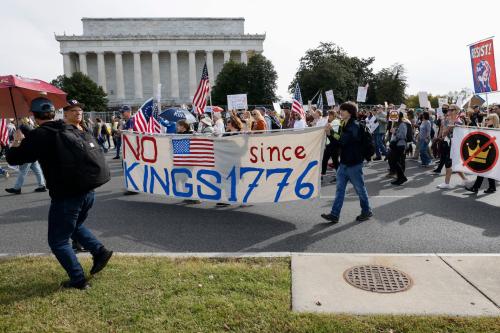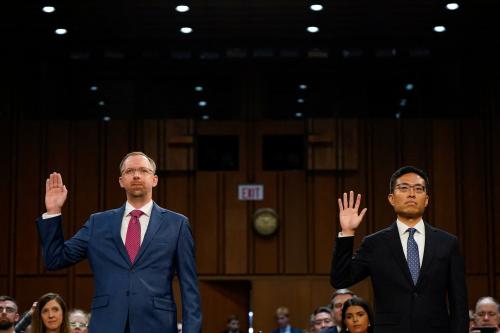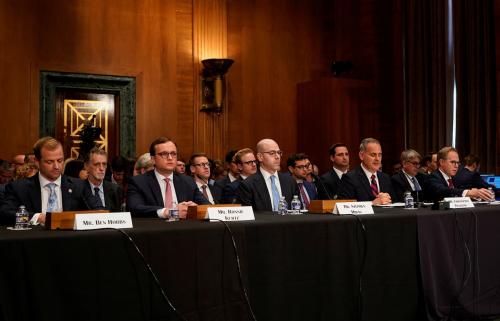Editor’s Note: As part of the 2014 Midterm Elections Series, experts across Brookings will weigh in on issues that are central to this year’s campaigns, how the candidates are engaging those topics, and what will shape policy for the next two years. In this post, John Hudak and Philip Wallach examine the marijuana legalization initiatives on the ballot this November. In addition, Hudak and Wallach will be hosting a Reddit AMA on the topic of marijuana legalization on Wednesday, October 29th at 10:00 AM EDT.
Ever since Colorado and Washington voters decided to make unprecedented policy experiments with legal recreational marijuana in 2012, there have been two big questions: What will the effects of legalization be, and will other states soon follow in their footsteps? We have each provided some very preliminary answers to the first question (Hudak’s Colorado report, Wallach’s Washington report), but the 2014 midterms will be the first big test for the second. Voters in Oregon, Alaska, and the District of Columbia will weigh in on whether their states should become second wave legalizers, with each confronting slightly different choices.
OREGON:
Oregon’s Ballot Measure 91 would very much follow in Colorado’s footsteps—only with even lower taxes. Like Colorado, Oregon developed a fairly robust regulatory system for its medical marijuana system that it proposes to convert to broader recreational purposes—thereby bringing honesty to a system in which “medical” often deserves scare quotes. Measure 91 would allow home grows (up to four plants) and non-commercial exchange while giving the state’s Liquor Control Commission broad discretionary powers to define the regulatory and licensing parameters of the state’s commercial market. Unusually, it does not offer a chemical definition of a marijuana DUI, instead launching a research effort meant to provide recommendations to the state legislature at the beginning of 2017 (Section 7(4)). Most notably, Oregon’s system would feature low taxes assessed on the basis of weight—just $35 per ounce. That is less than in Colorado, and, more importantly, far less than in neighboring Washington, leading some observers to wonder whether Oregon’s recreational system would end up effectively starving Washington’s (in spite of prohibitions on cross-state diversion). As legalization has taken off in other states, concerns arise over whether tax rates are too high to move people from the illegal market into the taxed and regulated legal market. Oregon’s efforts seek to remedy those concerns for Oregonians. The low taxes apparently make Oregon’s brand of reform—somewhat more regulation-oriented than the state’s failed Ballot Measure 80 in 2012, but still quite industry-friendly—the favorite of legalization advocates.
ALASKA:
Alaska voters will decide on Ballot Measure 2, which is similar to Oregon’s Measure 91 in many ways but is less detailed and features a somewhat higher tax of $50 per ounce. Alaska’s legislature is invited to create a new Marijuana Control Board, but if they do not, the Alcoholic Beverage Control Board is tasked with creating regulations and a licensing scheme. Again like Colorado, Alaska’s legalization would allow home grows (up to 6 plants, 3 flowering at any time) and non-commercial transfer alongside the regulated commercial system. Unlike Colorado, however, Alaska has little in the way of an existing regulatory framework around their medical marijuana system. The state relies wholly on home grows and caregivers for the production and supply of marijuana to the medical market, and Alaska’s possible foray into recreational marijuana will require the state to design, develop and implement regulations anew. This scenario presents a challenge for Alaska, and the state would be well served to work closely with other recreational and medical marijuana states to learn best practices—an effort in which legalization supporters have already been proactive.
WASHINGTON, D.C.:
D.C.’s Initiative 71, hailed and denounced, respectively, as legalization by both its supporters and its opponents, is really just full decriminalization. D.C.’s council already made possession of small amounts of marijuana a ticketable infraction with a fine of just $25 through a law earlier this year, but the ballot initiative would go even further, removing any penalty for possessing small amounts or making non-commercial transfers. But Initiative 71 does not, by itself, create a fully legal commercial marketplace or institute any taxation system, refraining from these tasks because of the limitations of the District’s ballot initiative process. Should Initiative 71 pass—which polling, indicating nearly 2-1 support, indicates is overwhelmingly likely—it will raise two questions. First, what will Congress do? Congress has ultimate jurisdiction over all of the affairs of the District and could act to reverse full decriminalization, although doing so would require bipartisan cooperation and so seems unlikely. Such a legislative veto would run counter to recent Congressional action that relaxes federal marijuana enforcement and numerous proposals to extend federal tolerance further. In a new Congress—and one in which both chambers may be controlled by Republicans—there are likely to be many other policy initiatives prioritized ahead of restoring marijuana prohibition in D.C. Second, will the D.C. City Council immediately move to implement a tax and regulate system comparable to Washington’s or Colorado’s through legislation? David Grosso (I – At Large) has sponsored a bill to do just that, creating broad regulatory powers for the Alcoholic Beverage Regulation Administration and imposing an excise tax of 15 percent on recreational and 6 percent on medical marijuana sales. Grosso’s bill would divvy up proceeds between D.C. Police, youth camps, youth courts, and prevention programs administered by the D.C. Department of Behavioral Health. But it isn’t clear exactly how fast the council could implement the new system, given the peculiarities of D.C.’s legislative process. Similar to challenges faced by Alaska, the D.C. system will suffer from limited, pre-existing experience in marijuana regulation and will likely need to learn from other states in constructing its new system.
So, what can we expect at the ballot boxes next week? Polling suggests a real chance that all three proposals may pass, with Oregon and D.C. quite likely. Such moves come in the midst of political elites and the public at large slowly changing their orientation on the issue.
In both states and the District, legalizers are better funded than opponents. That monetary advantage and a sense of momentum created by Colorado and Washington’s experiences favors legalization. But the nature of midterm electorates, which tend to be older, more Republican, and more traditionally conservative, makes legalization a heavier political lift than in a Presidential election year. Looking at it a different way, as Hudak did in August, causation might also run in the opposite direction: marijuana legalization may help Democratic candidates in an otherwise poor year, with potentially enormous results through the Alaska Senate race.
In the end, regardless of what voters in Oregon, Alaska, and the District of Columbia decide on November 4th, we can expect the legalization movement to expand and for 2016 to be the most crucial year for cannabis in the United States.
The Brookings Institution is committed to quality, independence, and impact.
We are supported by a diverse array of funders. In line with our values and policies, each Brookings publication represents the sole views of its author(s).




Commentary
2014 “Marijuana Midterms” to Establish 2016 as Most Crucial Year for Cannabis in America
October 28, 2014